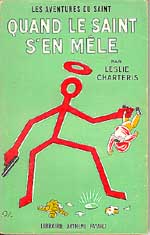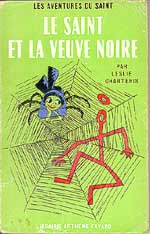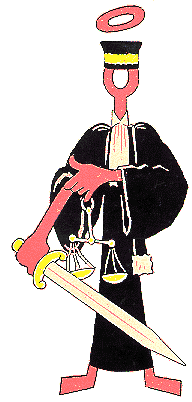|

Article Page 1
Article Page 2
Article Page 3
Article Page 4
Article Page 5
Bibliography
Cover Gallery 1
Cover Gallery 2
Cover Gallery 3
Cover Gallery 4
Cover Gallery 5
Cover Gallery 6
Cover Gallery 7
German covers by Regino Bernad
Le Saint Detective Magazine 1
Le Saint Detective Magazine 2
Le Saint Detective Magazine 3
Le Saint Detective Magazine 4
About Nero Wolfe & The Toff
About artist
Regino Bernad
The Saint on French Radio
French-English
Text Comparisons
De Saint (The Dutch Saint)

© 2001 Jean-Marc Lofficier. This article first appeared in a slightly different form in the Summer '94 issue
of The Epistle.
Thanks to Ian Dickerson for Research Assist.
Thanks to Dan Bodenheimer, Marcel Bernadac, and Patrick Verdant for additional cover scans.

|
 2. The radio "fix-ups" (1950-1953) 2. The radio "fix-ups" (1950-1953)
The first French Saint pastiche, No. 26 in the series, was published in 1950 under the title When the Saint Meddles. It was really an anthology
of three stories. In From Soja to Textile
(source material unknown), Simon exposes Lyman, a killer who uses an ultrasound musical instrument to commit murder.
In On the Edge of the Grave (based
on the radio script The Man Who Sang
by Maurice Zimm), he helps Fernack arrest a gangster, Dixon, who had secretly killed his associate, Blakely, who
had stolen a fortune in US Bonds. Finally, in The Doll's Head, which was based on the radio script Doll With
a Broken Head by Les Crutchfield, Simon finds a Chinese emerald hidden
inside a doll.
(I am very much indebted to Burl Barer's superb book The Saint: A Complete
History (McFarland, 1993) for the research concerning the radio scripts.)
The radio "fix-ups" were undoubtedly responsible for the bad reputation that the French Saint pastiches may have acquired. It was stated
in Barer's book (page 99) that the first few were reviewed, then rejected by Dutch publisher A. W. Bruna &
Zoon. (This, as it turns out, was entirely
inaccurate.) Furthermore, it is reported that Mr. Margulies, a friend
of Charteris, and Mr. Attenborough of Hodder & Stoughton felt that the French Saint pastiches were badly done and would, if retranslated into English, do great harm to Charteris'
reputation.
Despite this, it is worth noting that the Dutch Saint series continued very successfully for many years relying
on translastions of the French Saint. (See
article by Rinus Daane of the Dutch Saint here.)
Upon closer examination, this accusation appears to be somewhat well-founded, but the blame lies not with the French
publisher and/or Madeleine Michel-Tyl, but with the material handed to her, presumably by Charteris himself or
his publishers. I am referring, of course, to the radio scripts themselves.
Instead of his suave and debonair self, a British version of Arsène
Lupin, Simon suddenly turns into an American tough guy, straight out of
a Peter Cheyney novel. And, needless to say, all the stories now take place in America. The transition is awkward
at best, and reflects more on Michel-Tyl's desire, at first, to be faithful to the tone of the material she was
given, rather than her own presumed incompetence.
Michel-Tyl's adaptation from the radio scripts are, stylistically and plot-wise, competent. But they just do not
feel like Saint novels -- at least
from a purist's eye -- and one can understand the Dutch publisher's rejection.
On the other hand, one strongly questions Mrrs. Attenborough's and Margulies' judgment. Certainly, their harsh
comment regarding the quality of Michel-Tyl's work was not only unwarranted, but ignorant. One wonders if their
knowledge of French was adequate enough to enable them to properly assess the situation. In any event, no matter
how flawed their reasoning may have been, their decision was ultimately right, since Michel-Tyl's radio "fix-ups"
would probably have not survived one more translation, back into English.
 Certainly, it
would appear that both Fayard and Michel-Tyl quickly reached the same conclusion than the Dutch publisher. No.
27 in the series, entitled The Law of the Saint,
was another three-story anthology written in the "tough guy" mode, in the same style that must have put
off the Dutch publisher, if he ever saw it. The book included The Wine
Bottle Rack, based on radio script Family
Gun Play by Michael Cramoy; The
Bells, based on the radio script Rare
Painting Smugglers by Michael Cramoy; and The
Filipino Carpet, based on radio script Murder
for a Buried Treasure, also by Michael Cramoy. Wisely, Michel-Tyl tried,
whenever she could, to combine radio scripts by the same writer. Certainly, it
would appear that both Fayard and Michel-Tyl quickly reached the same conclusion than the Dutch publisher. No.
27 in the series, entitled The Law of the Saint,
was another three-story anthology written in the "tough guy" mode, in the same style that must have put
off the Dutch publisher, if he ever saw it. The book included The Wine
Bottle Rack, based on radio script Family
Gun Play by Michael Cramoy; The
Bells, based on the radio script Rare
Painting Smugglers by Michael Cramoy; and The
Filipino Carpet, based on radio script Murder
for a Buried Treasure, also by Michael Cramoy. Wisely, Michel-Tyl tried,
whenever she could, to combine radio scripts by the same writer.
Starting with No. 28, Michel-Tyl slowly reverted to using a style that became increasingly "laid back",
closer to that of the original Saint.
She was also no longer satisfied with simply adapting three scripts into three short stories, but started creatively
weaving three unconnected scripts into one single novel, often changing the names of the characters, etc. (This
elaborate reconstruction work makes the discovery of the source material very difficult.)
No. 28, entitled The Saint Brings Back an Heir,
was one single novel, clearly made up of three interconnected stories. The first, The
Saint's Mission (possibly but, in that case, very loosely based on Murder on the High Seas by Michael Cramoy), sets
the stage: Hamilton, Simon's OSS contact, asks the Saint to bring back the heir to an enormous forture, one Bodhan
Kupchinsky, from India. Bodhan turns out to be an old scientist. On board the return ship, Simon foils a plot by
the villainous Nadia to kill Bodhan and take his place. The story continues with The
Lions' Train, based on Michael Cramoy's Baseball
Team Shooting, and finally culminates with King
Olsen, based on Sidney Marshall's The
Steel Ice Murders.
With No. 29, entitled The Saint Refuses to Sing,
Michel-Tyl became increasingly clever in her "fix-up" technique, smoothly blending plot threads from
Michael Cramoy's Blackmail and
Ken Crossin's Baby Adoption Blackmail Ring
into an excellent thriller about a nationwide ring of blackmailers. No. 30, The
Saint and the Lame Duck, similarly combined Michael Cramoy's The Disappearing Dentist, Howard Dimsdale's Tiger by the Tail and Margolis & Morheim's
Night Club Story.
 No. 31, The Saint and the Black Widow, was probably Michel-Tyl's
best "fix-up" of the period. It combined three of Cramoy's best efforts: Hard
Money, The Latest Style in Murder and Pearls Before Swine
into a tautly-paced, relentless thriller, at the end of which Simon discovers that his lady companion, Marie Virva,
who called on him to solve the murder of her ex-husband, in in reality the mysterious Black Widow, the leader of
the merciless gang of racketeers -- a substial dramatic improvement on the original scripts. No. 31, The Saint and the Black Widow, was probably Michel-Tyl's
best "fix-up" of the period. It combined three of Cramoy's best efforts: Hard
Money, The Latest Style in Murder and Pearls Before Swine
into a tautly-paced, relentless thriller, at the end of which Simon discovers that his lady companion, Marie Virva,
who called on him to solve the murder of her ex-husband, in in reality the mysterious Black Widow, the leader of
the merciless gang of racketeers -- a substial dramatic improvement on the original scripts.
The next volume, The Angels Call For the Saint
(No. 32), takes place in Los Angeles and combined three of Howard Dimsdale's scripts: Playing
with Fire, The Fence and Crime Wave.
Then, The Saint Bets on Death
(No. 33) combined Dimsdale's The Saint is Framed
with two Joel Murcott scripts: The Death of a Fighter
and Jailbreak.
Even though Michel-Tyl had managed, to a large extent, to turn a sow's ear into a silk purse, the days of the "tough
guy" Saint were numbered.
Three years later, in 1954, Fayard either decided to discontinue the use of the radio scripts, or someone else,
very likely Leslie Charteris himself, instructed that they no longer be used. Mrs. Charteris' comment that her
husband intervened when he felt that the quality of the novelizations had become unacceptable, and offering instead
the comic scripts that he had himself written as source material, would appear to validate the second hypothesis.
In any event, Fayard switched to the New York Herald- Tribune comic-strips for inspiration for its Saint novels. Because these were written by Charteris, with full dialogue and descriptions,
they provided Madeleine Michel-Tyl and her editors with much better quality source material.
In total, and as far as I can determine, only twenty-four radio scripts were used, and all came from the first
fifty-one episode series. No later scripts seem to have been used. (This information is difficult to ascertain
as it requires careful plot comparisons.)
PART 3 TO BE CONTINUED ON NEXT PAGE:

|

